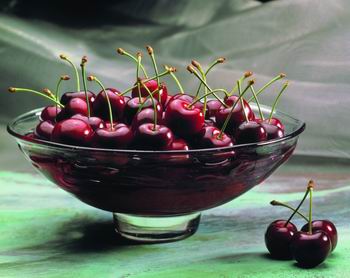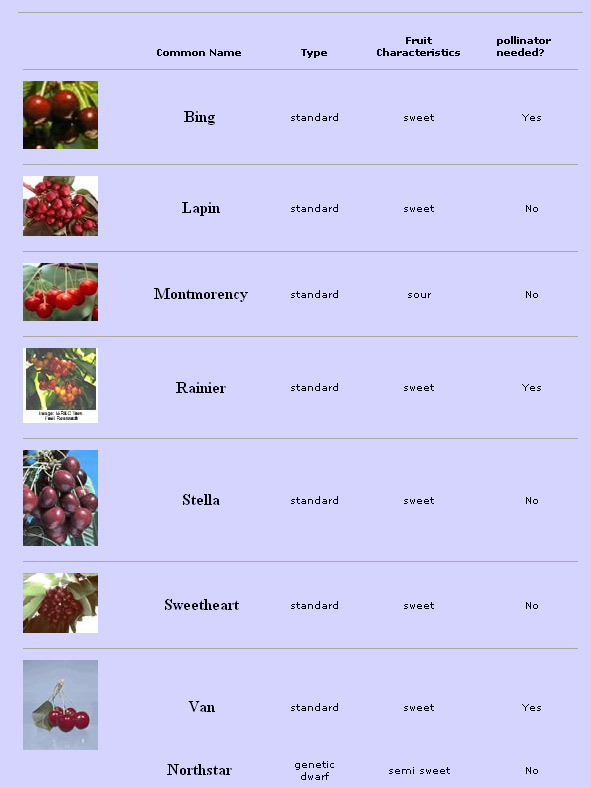 |
There are two types of cherries that are commonly grown: the sour cherry which is the most popular and is widely adapted is used in processing and pies, and the sweet cherry which may be eaten directly off the tree. Two varieties of either type should be planted for cross-pollination
Two cherry types are grown for their fruit, the `sweet', dessert (Prunus avium) and the `sour', culinary (Prunus cerasus). A third type, the 'Duke' cherries, such as the Northstar form an intermediate class. The sweet are subdivided into the 'black' and 'white' varieties. All fruiting cherries are hardy except in the extreme north though the blossoms may be damaged by late spring frosts.
Cherry trees range in size, from 6 to 30 feet tall depending on the cultivar. There are also some shrub cherry cultivars such as 'Red Nanking' cherry. |
In addition there is the Japanese flowering cherry (Prunus subhirtella) which is a cultivar of Japanese flowering cherry or Oriental cherry. It can grow to 20 to 35 feet tall. New leaves are reddish, and mature to lustrous dark green, and then change to red or bronze in the fall. The profuse, fragrant spring flowers can be single or double, white or a shade of pink, from half an inch to almost 3 inches across. The fruit is dark purple. However, the Japanese flowering cherry is short-lived and beset by many insect and disease problems.
Forcing Branches into Bloom |
Adding the right flowering trees and shrubs to your landscape will ensure an explosion of color in early spring. Choose carefully, and you'll have a bonus of branches you can bring indoors. For the best results you should understand what you can do before the season, get placement tips, and read up on forcing basics.
Named varieties of cherries can be propagated on rootstocks by budding in July and August, or by grafting in March. Seedling Mazzard and the clonal Malling F 12/1 rootstocks are used usually for rootstocks. A mature sweet cherry tree may be up to 30 ft tall with a corresponding spread, too large for the average garden but bush Morello (sour) trees rarely exceed a height of 15ft. A genetic dwarf, Northstar, is available with characteristics between the sweet cherry and sour cherry.
Sour cherries do well in almost any situation and are particularly valuable for training as fan trees against a north-facing wall unsuited to other fruits. Although sweet cherries can also be grown as fans, they dislike hard pruning and are happiest as standards or half standards given minimum pruning. Plant standards 30ft apart, half standards 25ft, and bush and fan trees 15ft apart. Cherries as a class dislike poorly drained, heavy soils. The sweet varieties do well on deep, light to medium loams while the sour ones will tolerate poor soils, as long as it is not waterlogged.
Morello cherries are self-fertile and will pollinate any sweet cherry that flowers at the same time. Most sweet cherries are infertile with their own pollen and often with certain other varieties so it is important to select varieties for interplanting whose blossom period coincides or overlaps. A few varieties called universal donors are compatible with all groups flowering at the same time. The dessert cherry season extends from mid-June to mid-August and is somewhat dependent on weather. Culinary kinds are used throughout the year for cooking, or making into jam, pie or cherry juice.
( Prunus Avium)
The three wild forms of cherry trees are popularly distinguished under the names Bird Cherry (P. Padus), Wild Cherry, or Gean (P. Avium), and Dwarf Cherry (P. Cerasus); and though they agree in their botanical characters and geographical distribution, yet there are distinctive points which are sufficiently obvious to be explained in simple language.
The geographical range of the three forms is nearly the same, namely, from the Himalayas, through Western Asia, Northern Africa, and Europe; but the Dwarf Cherry seems the more restricted form, not occurring either in Scotland or in Africa, whilst the Bird Cherry occurs in the Arctic regions both of Europe and of Asia.
Cherries are classified, by the various details in their structure. They are related to that great group of plants known as the Rose tribe. This tribe embraces, the Oak, great numbers of trees, Roses, Brambles, Strawberries, Cinquefoils, and Meadow-sweets, and also Apples, Pears, Medlars, Quinces, Hawthorns, Black-thorns and Plums. These are united by botanists in the genus Prunus, a group mainly characterized by the structure of its well-known fruit, which is called a "drupe." It is the enlarged ovary of the flower, the calyx of which has fallen. It is one-chambered, contains but one, or at most two, kernels or seeds, and is plainly divisible into an outer skin, a fleshy pulp, and a stone enclosing the kernel or kernels.
There are two differences, however, that clearly distinguish the Blackthorns and Plums from the Cherries; in the former the two halves of the blade in the young leaf, when in the bud, are rolled up like a scroll, while in the Cherries they are folded together like the two halves of a sheet of note-paper. In the Plum group the fruit is covered by the beautiful and familiar waxy bloom, that serves to shoot off the rain-drops but the fruit of a Cherry is smooth and has brilliantly burnished surface.
The Bird Cherry (P. Padus) is more distinct from the others. It is a small tree with one main trunk, reaching ten or twenty feet in height. Its leaves are smooth, and finely and regularly toothed; but its chief distinctive mark is the arrangement of the blossoms, which is what is technically known as a "raceme"--i.e., the flowers, which are numerous, spring singly on short stalklets from an elongated pendulous axis. The fruit is small, round, and black, harshly bitter in taste, and encloses a round wrinkled stone. The astringent bark of this species has been proposed as a substitute for quinine.
The Gean (P. Avium), is a tree from twenty to thirty feet or more in height, and with q trunk that is sometimes more than nine inches in diameter. It grows in dry, rocky woods, and yields a beautiful red timber, fine grained, and tough enough for tool-handles. The leaves are drooping, and downy on their under surfaces, and the flowers, which are produced somewhat later, are arranged in "umbels"--i.e., each on a rather long stalk springing with the others from one point, like the ribs of an umbrella. The fruit is heartshaped, firm in flesh, and not very juicy, bitter in taste, and either black or red. From it is distilled the Kirschwasser of Germany, and it is probably the wild original of the Morella.
The Dwarf Cherry (P. Cerasus) is a bushy shrub, from three to eight feet in height, with a reddish bark, and with short-stalked, erect, and coarsely-notched leaves. Its flowers, too, are arranged in umbles, and its fruit is round, red, and acid, being distinguished by this acidity and by the comparative abundance of its juice. It is believed to be the origin of our sweet garden Cherries; though, even if this be so, it does not militate against the statement that the latter are a late introduction from Asia, whilst the Dwarf Cherry appears truly wild over a large part of Europe.
With so much beauty, and being valuable timber, it is strange that the Cherry should have attracted little attention from John Evelyn, the pioneer of English forestry. The maraschino is manufactured from an allied species in Dalmatia and the north of Italy. Its timber is a close-grained red wood that is easily worked and takes a fine polish almost equal to mahogany. It is often requested for the manufacture of certain musical instruments, and is valued as a forest tree. The Gean (P. Avium) will grow straight upwards if planted close together; and, since it is a fast-growing tree, is adapted for planting as a "nurse" for oak, for admixture with the slower-growing, but longer-lived, timber-trees, to draw them up, being subsequently felled to make room for their further development. The Cherry, when grown under these circumstances may reach a height of sixty or seventy feet in fifty or sixty years; and though it will then be cut so that the forest monarch may rule alone in his domain. Up to that time, owing to the loose and ascending arrangement of its boughs, the cherry will not require pruning to let in the light upon the young oaks.

Flowering Cherries, Weeping Cherry Trees
Weeping cherry trees must be included in any Top 10 list of weeping trees, since they are spectacular flowering trees as well. In fact, below I mention two additional flowering cherry trees that do not have a weeping habit, so as not to shortchange this indispensable component of spring landscaping.
The weeping Higan cherry can be grown in zones 4-8. Weeping Higan cherry trees (Prunus subhirtella 'Pendula') produce pink to white flowers in profusion, if grown in full sun and well-drained soil. This weeping cherry tree attains a height of 20'-30' and a spread 15'-25'.
"Snow Fountains" weeping cherry (Prunus 'Snow Fountains' or 'Snofozam') is suitable for landscapes in zones 5-8. Height 8'-15', spread 6'-8'. Snow Fountains blooms best in full sun and well-drained soil. A slow-growing ornamental, the branches of this weeping cherry cascade right down to the ground.
But while on the subject of flowering ornamental cherry trees, it's hard to pass over a couple of widely grown upright (i.e., non-weeping) specimens. Japanese flowering cherry, or Kwanzan cherry (Prunus serrulata 'Kwanzan') grows 15'-25' x 15'-25'. Its white to pink blooms will be most impressive when the tree is grown in full sun with good drainage. Zones 5-8.
Another cherry tree with an upright habit, the purple leaf sand cherry (Prunus x cistena) is suitable for growing in zones 3-8. Purple leaf sand cherry has a moderate growth rate and, like the other cherries, prefers full sun and a well-drained soil. Height 7'-14', spread 7'-10'. An added bonus with this ornamental cherry is its striking summer-long reddish-purple foliage and its fragrant flowers.
| Back to Top |
https://gardeningfromthegroundup.us/Cherries.htm